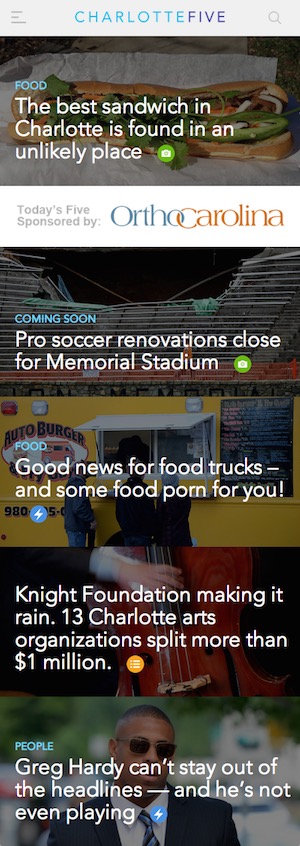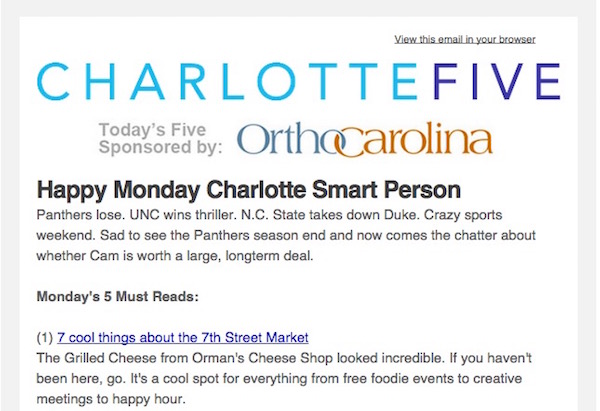
Every weekday at 7 a.m., the countdown clock atop the Charlotte Five homepage resets — counting the hours, minutes, and seconds until another batch of five stories are posted.
That’s the hook behind Charlotte Five, launched last November by The Charlotte Observer: As its name suggests, the site only publishes five stories per day. The posts all go up on the site at once and go out in a daily email newsletter. And right underneath the countdown clock is the number of pageviews this batch of stories has received. (There’s a turnaround: Gawker is deemphasizing its traffic stats, but a newspaper is pushing its public.)

The site is an effort by the Observer to reach a younger audience. Like those of most major metropolitan newspapers, its core readership is aging while Charlotte’s millennial population grows — and national outfits like BuzzFeed have won young residents’ attention in ways the local daily might have before the web.
“One of our goals for 2015 is to reach the young demo here in the Charlotte area. And that demo has local news as a light interest, so they care a little bit about it,” said Ted Williams, the Observer’s director of digital strategy and new initiatives and the lead on Charlotte Five.
“We also thought that it would need to be a blend of news and entertainment stories,” he said. “As we look at this market, in general, the digital advertising market is growing and large. The young population in Charlotte is also growing. So we’re looking for a lightweight product to reach them.”
The median age of an Observer reader (print and online combined) is 46; between 2009 and 2012, Charlotte’s millennial population growth was the 10th highest in the United States, according to a 2013 Brookings Institution study.
In addition to aggregated coverage of local news and entertainment, Charlotte Five also focuses on what Williams calls “Seinfeld Journalism,” original content that is “stuff people talk about but isn’t really news” — like a ranking of the eight worst parking lots in the city or a post Williams wrote describing how he had to take the SAT because he finished last in his fantasy football league.
Charlotte Five’s website is responsive, but site was designed to be mobile first — the desktop version is essentially just an enlarged version of the mobile site, with the photos stretching out horizontally. The stories are also optimized for phone consumption, with lots of lists, bullet points, and chunks.
 For example, when last week a group of Charlotte private and civic organizations pledged $11 million to eradicate chronic homelessness in Mecklenburg County, where Charlotte’s located, by 2016, the Observer covered the announcement with a 1,200-word news story and an editorial supporting the plan on the opinion page.
For example, when last week a group of Charlotte private and civic organizations pledged $11 million to eradicate chronic homelessness in Mecklenburg County, where Charlotte’s located, by 2016, the Observer covered the announcement with a 1,200-word news story and an editorial supporting the plan on the opinion page.
Charlotte Five, meanwhile, published “8 sobering stats about Charlotte’s homeless problem,” linking back to the original Observer news story while also embedding tweets and including additional facts.
Most posts on the site follow a chunked-up template, with subheads listing The Story, The Facts, and then C5’s Take, offering the site’s perspective on whatever it is they’re covering. (Charlotte Five’s take on a recent post about potentially dating Carolina Panthers quarterback Cam Newton after Town and Country named him one of its 50 top bachelors of 2015? “Yes we would date him. Especially because he’ll smell good with his new Drakkar Essence endorsement and we’d have unlimited brogurt with his new Oikos endorsement.”)
That’s the sort of voice Charlotte Five wants in its stories. Jen Rothacker, the Observer’s innovation editor, who also works on Charlotte Five, described it as a “breezy and easy” read that doesn’t take long to consume and is meant to be shared. They also highlight the finite nature of the product, arguing that if you read the five stories in Charlotte Five everyday, you’ll know what’s important and what’s going on in the city and won’t be overwhelmed by the constant stream of content on Twitter or Facebook.
“We don’t have a lot of young readers for our core products at the Charlotte Observer, especially our legacy print. Not many young people subscribe to the paper,” Rothacker said. “We are the source of local news in town, and we want people to read this. This is an entry point for them, so having that voice just makes it feel more comfortable for that crowd.”
For now though, that crowd is small, but growing. In December, Charlotte Five had 78,157 pageviews and 45,429 unique visitors. By year’s end, there were also 409 subscribers to its daily newsletter. (“Our handcrafted, human daily newsletter.”) Williams said the site is focused on developing a core readership that comes to the site daily and reads all five stories: “Our goal within the first six months is to try and get 1,000 people to love us in that demo.”
Charlotte Five was conceived at an off-site management retreat last year; it took about 75 days from the time the project was approved to when the site went live around Thanksgiving. Since then the Observer hasn’t marketed the new site; there’s no mention of it at all on the Observer’s main site, and the only mentions of the Observer on Charlotte Five are deeply buried on its about page.
“We’re doing this on purpose,” Williams said. “We have to make the content good enough for people to share it. If we’re not creating remarkable content then we’ve failed because that is the marketing. It’s a little bit cutthroat sounding, but if people didn’t respond or share anything, then we’d fail — we’d just be an unpopular standalone thing.”
As of now, Charlotte Five has been run separately from the Observer newsroom, but Williams said there have been very preliminary discussions on how the two could potentially work together, but he said “we don’t know how these brands go together — or if they even should.” Williams said they’ll look to refine a marketing plan for the site later this year.
Still, the paper isn’t taking a huge financial risk with Charlotte Five as the costs are minimal and the site has had advertising support from the start. OrthoCarolina, a large local orthopedics practice, has been the sole advertiser thus far, attaching its brand to the website and email newsletter as the presenting sponsor.

OrthoCarolina has a significant marketing presence throughout Charlotte, advertising on everything from local TV and radio to billboards, airport signage, and more digital targets like paid search. But Blair Primis, OrthoCarolina’s director of marketing, said Charlotte Five offered a younger audience that was appealing to the company — even if you might not associate millennials with an orthopedics practice.
“While it might not be a data point that we can point to and say, ‘Wow, we got a patient because we helped sponsor Charlotte Five,’ I do say that there’s something longer term that makes sense for our two brands, and that’s something I think we’re already getting a return on,” Primis said. “The second thing would be showcasing our services and the things that we offer, as well as our original content, to this target audience.”
For now, OrthoCarolina’s advertising has been limited to being the presenting sponsor for the site and newsletter, but Charlotte Five would eventually like to add native advertising as well. But aside from the costs associated with actually setting up the site, though, the Observer’s costs are limited to Rothacker increasing the number of hours she works each week (from 30 hours to 40 hours) and a bumped-up freelance budget, she said.
Williams and Rothacker are the primary Observer staffers working on the site — “Jen and Ted’s Excellent Adventure,”, she called it — but they still have other responsibilities at the paper and can’t dedicate all their time to running Charlotte Five. They rely on a network of four freelancers to contribute material for the site, though Williams said he’d like to have up to 10 freelancers total writing.
Both credit the freedom the Observer has given them to experiment along with the cooperation between the business and editorial teams as part of the reason Charlotte Five has gotten off the ground. Williams and Rothacker are in constant contact about the site. Rothacker will usually work later in the evening, writing up many of the posts that will go into the next day’s Charlotte Five. Williams takes the early shift, sending out the newsletter every day.
And once the newsletter hits subscribers’ inboxes at 7 a.m., their work, and the countdown to the next day’s five stories, begins again.